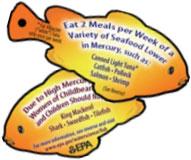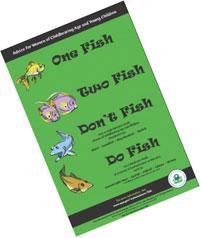National Listing of Fish Advisories General Fact Sheet 2011
December 2013
Since 1993, the EPA has made the National Listing of Fish Advisories (NLFA) available to let people know about locally-issued fish advisories and safe eating guidelines. States, territories (called "states"), and tribes provide this information to the EPA every year.
Until 2004, we published a summary of the most current information in the NLFA every year. In 2005, the EPA decided to do this every two years because changes from year to year had been very small. However, this year's summary describes one year's worth of data, the fish advisory data for 2011.
In addition to providing a central location where people can find data about fish advisories, the EPA produces materials to help people understand the risks of eating contaminated fish and the benefits of eating fish as part of a healthy diet.
On this page:
- Basic Information about Fish Advisories in the United States
- National Listing of Fish Advisories website
- 2011 National Listing
- Safe Eating Guidelines
- Bioaccumulative Contaminants
- National Advice Concerning Mercury in Fish
- For More Information
Basic Information about Fish Advisories in the United States

States issue fish consumption advisories to protect people from the risks of eating contaminated fish caught in local waters. A consumption advisory may recommend limiting the amount or avoiding eating certain fish from specific waters or from specific water types (like "all lakes").
States may issue an advisory for everyone or for groups like pregnant women, nursing mothers, and children. In recent years, states have been using statewide advisories to warn about risks from widespread contamination. In our summaries, they count as one advisory.
In contrast, states also issue safe eating guidelines to let people know that fish from specific waterbodies are safe to eat. Differences in the way states monitor, make decisions, and communicate to citizens make it hard to do comparisons or establish national trends.
EPA's Fish Advisory
EPA's Fish Advisory website offers details on the advisories issued. For each advisory, you will find specific information about the species, location, contaminants, status and year issued. When you visit the website, you can get detailed local information and maps. You can also find links to state fish advisory programs and your state's fish advisory program contact for more up to date advisory information.
2011 National Listing

Each statewide advisory counts as one advisory in our totals, so looking at the number of advisories may be a little misleading. That's why we also use total lake acres and total river miles subject to advisories to get a sense of their extent across the country.
For 2011, the NLFA showed that states issued 223 new fish advisories. The 2011 total of 4,821 advisories covers 42% of the Nation's total lake acreage and 36% of the nation's total river miles. To get more details on the waters under advisory refer to the technical fact sheet and questions and answers.
Safe Eating Guidelines
Safe eating guidelines let people know when there are no limits on eating fish from specific waters or certain fish species. While there were only 20 safe eating guidelines in effect in 1993, that number rose to 908 in 2010 and 1,040 in 2011. In 2011, 21 states had safe eating guidelines in effect.
Two percent of river miles and 10% of lake acres in United States had safe eating guidelines for at least one fish species. The overall geographic area covered by safe eating guidelines increased in 2011.
Bioaccumulative Contaminants
Ninety–four percent of all advisories in effect in 2011 involved five bioaccumulative chemical contaminants: mercury, PCBs, chlordane, dioxins, and DDT. These contaminants accumulate in fish tissue at concentrations many times higher than concentrations in the water and can persist for years in sediments, where bottom-dwelling creatures eat them and pass them to larger fish.
The total number of advisories for mercury increased from 3,710 in 2010 to 3,921 in 2011. Most states have issued mercury advisories, and 81% of all advisories were based at least partly on mercury. As of 2011, 25 states have statewide advisories for mercury in freshwater lakes and/or rivers. Sixteen states have statewide advisories for mercury in their coastal waters, and one state has a statewide advisory for mercury in marine fish.
Between 2010 and 2011, advisories for PCBs increased from 1,084 to 1,102. Four states have statewide advisories for PCBs in freshwater lakes and/or rivers, and nine states have PCB advisories for their coastal waters.
Chlordane use was banned in the United States in 1988, and this contaminant continues to degrade in the environment. There were no new fish consumption advisories issued for chlordane in 2011.
Dioxin advisories increase from 128 in 2010 to 129 in 2011. The geographic area covered by dioxin advisories is extremely small, in part because of the high cost of analysis and the location of facilities that release dioxin.
Although the use of DDT has been banned since 1975, the number of DDT advisories increased from 58 in 2010 to 67 in 2011. The size of waters under advisory increased slightly.
National Advice Concerning Mercury in Fish
In 2004, the EPA and the U.S. Food and Drug Administration issued advice for women who might become pregnant, women who are pregnant, nursing mothers, and young children. You can learn more about this advisory here.
For More Information
For more information on specific advisories within a state, contact the appropriate state agency. For more information on how to reduce exposure, consult the EPA's brochure What You Need to Know About Mercury in Fish and Shellfish, available in several languages. You can also send an email to Samantha Fontenelle (fontenelle.samantha@epa.gov) to learn more about the National Listing of Fish Advisories.
